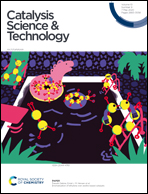pH-Controllable regeneration and visible-light photocatalytic redox of carbon and nitrogen co-doped Zn3Nb2O8 towards degradation of multiple contaminants†
Abstract
The visible light photocatalytic activity and stability of bare Zn3Nb2O8 and carbon doped Zn3Nb2O8 (C–Zn3Nb2O8) were enhanced with nitrogen and carbon co-doped Zn3Nb2O8 (N/C–Zn3Nb2O8) for the oxidative and reductive degradation of pH-sensitive substrates, such as Cr(VI), Cu(II), methyl orange, and tetracycline hydrochloride. Compared to pure Zn3Nb2O8, the band structure of N/C–Zn3Nb2O8 was optimized with the conduction band at −0.37 eV and the valence band at 1.61 eV due to the co-doping of nitrogen and carbon, which could stimulate the formation of ˙OH and ˙O2− radicals. Moreover, the N/C–Zn3Nb2O8 catalyst was highly improved by the synergistic effect of carbon and nitrogen dopants on the visible light absorption, the charge conductivity, and the electron–hole pair separation. In addition, the N/C–Zn3Nb2O8 catalyst with a negatively charged surface and layered structure can selectively adsorb and degrade some pH-sensitive pollutants, thus achieving high photocatalytic activity in visible light irradiation and stable recyclability by designing a regeneration test and controlling the pH range.



 Please wait while we load your content...
Please wait while we load your content...